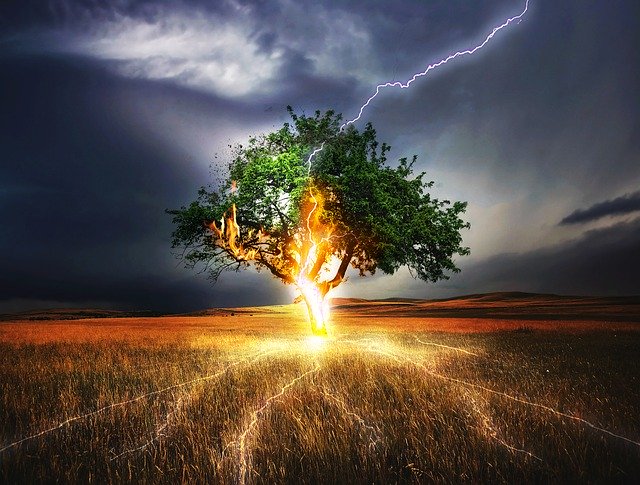Table of Contents
Some links on posts are affiliate links and will earn us a commission from qualifying purchases
Whilst electrical thunderstorms can be quite exhilarating to watch in the distance, from the safety of your own home, what should you do if you are caught in a thunderstorm while out walking?
If you are out walking and caught in a thunderstorm approaching, the most important thing is to seek safe shelter at the lowest point you can get to safely. Ideally you will manage to find a building, but there are other places that can be safe, and some definite places to avoid.
What causes a thunderstorm?
Water vapour from the earth evaporates into the atmosphere, and turns into droplets of water in clouds. When these are large, cumulus clouds, due to the size the drops at the top of the clouds start to freeze.
Large raindrops hold a negative charge, whilst small raindrops hold a positive charge. If the larger raindrops start to fall before the smaller raindrops, then an electrical charge is created in the gap in between them. This is what causes the lightning.
What is thunder and lightning?
Thunder is the sound of the lightning. You may ask why you don’t hear thunder at the same time then, but that is all down to speed. The speed of light (lightning) is much quicker than the speed of sound (thunder).
The difference in these two speeds will tell you how far away a thunderstorm is. When you see lightning strike, start to count the number of seconds before you hear thunder. Divide the number of seconds you count by 5, and that equates to the number of miles away.
If that number comes down, then you know that the electrical thunderstorm is coming your way, and that you need to get safe!
Before the thunderstorm
If you are planning a walk, and you have a feeling that there may be a thunderstorm brewing, then it would be best to consult a localised weather report before you even set off. This may convince you that it would be safer to stay at home, or again may give you the confidence that a thunderstorm is highly unlikely after all.
If you are staying somewhere on holiday but planning to walk, it may well be worth talking to locals to help you understand the localised pattern of thunderstorms. They may well tell you that thunderstorms tend to only occur in the early evening, in which case a morning walk would be wise, so you are back well before that time.
If it’s humid whilst you are out walking it would be wise to keep an eye on the cloud formations in the distance. If they start to turn dark and you see them becoming electrical way in the distance, now is the time to plan your escape.

What to do in a lightning storm to stay safe
Once you get to the stage of finding safety, you need to look for shelter as soon as possible. Ideally you will be able to get into a safe building, but that may not be possible.
If you are near your car, you can seek shelter in that, but make sure that you don’t touch any metal parts. If your car is inaccessible and yo find that you are still out in the open, then you need to find somewhere that will give you the best opportunity of not being struck by lightning.
Aim to get lower down any hills that you may be on, ideally reaching the valley floor. However, if there is a stream at the bottom, then stay away from this, as water conducts electricity. If there is no stream, take a good look at the ground – does it look like any possible flash flooding may run through it? If so, again, don’t get stuck in this.
If there is a cluster of low trees amongst a group of taller trees, these will offer you some form of protection. Lightning is more likely to strike the taller trees that surround them. But at all costs avoid a single lone tree in a field – it will be much better just to get soaking wet.
If you are carrying a heavy backpack, does it have a metal frame? If so, take your rucksack off, put on your wet weather gear, and leave the rucksack on the ground. Get about 100 feet away if possible. If you have walking poles, then leave those with the rucksack.
If you are in a group, it’s best to split up. As it may be scary, perhaps split into couples to give reassurance to each other and help if required.
If you feel your skin start to tingle and the hairs on your arm start to stick up, lightning is about to strike. Crouch down as low as possible, balancing on the balls of your feet, and hold your hands over your ears whilst you close your eyes. This will make you the lowest you can be, and with the least amount of contact with the ground, and give you the best chance of not being hit.
If lightning strikes ground nearby, it will shoot along the ground in a random way, a bit like roots growing underground. By being on the balls of your feet you are minimising the chance of getting caught that way.
Worst places to be during a thunderstorm
There are certain places that you just don’t want to be in when lightning strikes. This can be seen from the table below, which shows the number of deaths in the US between 2006-16:
| Out in the open | More than 160 deaths |
| Under a lone tree | More than 80 deaths |
| Unknown | More than 20 deaths |
| In a boat | Less than 20 deaths |
| In water | About 15 deaths |
Also avoid small structures like picnic shelters, flagpoles or lampposts – these will offer no protection whatsoever, and will attract lightning.
If you do find that one of your group has been struck, make sure you call the emergency services as quickly as possible. The person will be safe to touch, so if you know CPR and it is required, then start to perform this.
After the thunderstorm
Thunderstorms will pass over with the wind. But as lightning can strike anywhere up to 10 miles away from it’s source, it’s important not to venture out to soon. Wait for at least 30 minutes after the last rumble of thunder that you hear – it’s much better to be late and safe than risk continuing on your way too soon.
Conclusion – What to do if you are caught in a thunderstorm whilst out walking
It is quite rare for people to be struck by lightning, but it’s also wise to know what your options are if you find a storm nearing. The most important thing is to make yourself as safe as possible, ideally in a building. By taking note of the points above, you will have at least educated yourself to what actions you should take.
Recent Posts
Which is best? Morning walk vs Evening walk | Pros & Cons for both
Fitting walks in on weekdays into your daily schedule can be a bit of a juggling experience. It is best to try and stick to a particular time, if at all possible, but obviously this is not always...
Hiking is a great way to enjoy nature and get some exercise, but for some people, hiking can be uncomfortable or even painful. If your hands swell up when you walk, you're not alone. This common...


